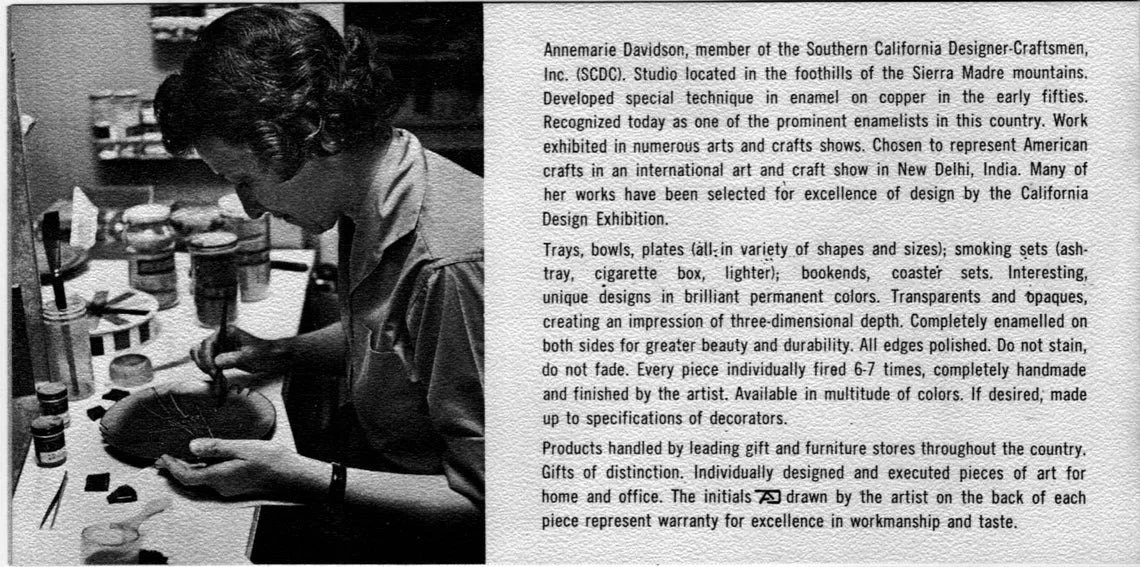Annemarie Davidson Jewel Bookends
Annemarie Davidson Jewel Bookends
Designer: Annemarie Davidson (1920 – 2012)
Item: Enamel Jewel Bookends
Manufactured by: Annemarie Davidson and Blaine Rath
Country of origin: United States
Year made: Circa 1960s
Materials: Copper, enamel, glass inset into Mahogany wood blocks, cork bottoms.
Dimensions: Each are 7” x 4 ½” x 2 ¾”
Condition: Excellent. The enamel plaques are flawless. The wood has a few scratches and small dents as shown. The cork bottoms have some small bulges where the cork expanded likely by exposure to some moisture.
Description: Here is a beautiful pair of very heavy bookends by Annemarie Davidson in thick Mahogany blocks fabricated by the artist Blaine Rath with heavy enameled copper plaques by Davidson inlaid into the wood. The decoration on the enamel work is Davidson’s most highly regarded and collected Jewels design where she used glass and thick enamel to achieve a rich irradiance, glow and three-dimensional surface on the enamel. This design is similar to a couple others we have seen with psychedelic orbs and ray bursts. These abstracted Jewels designs are considered her most highly acclaimed and accomplished art works. Each bookend is signed on the bottom with her cypher initials as shown. Each weighs about 4 pounds so they do hold up books.
Davidson appears to have earned a living making decorative enamel plates and dishes with designs of animals, birds, flowers, clowns, landscapes, and other objective imagery drawn from the real world. We have even seen them with pictures of golf courses. These were made for the commercial market in great numbers and are ubiquitous, inexpensive, and are easily found in secondhand and thrift stores. However, the Jewels works were her “fine art” and demonstrate a true artistic talent that is becoming quite sought after. The Jewels works are also a great accompaniment to midcentury modern designed furniture and interiors. Davidson’s desk accessories (i.e. lidded boxes, pen holders, blotters, bookends, etc.) were a collaboration with the noted woodworking artist Blaine Rath starting in 1959 and are much harder to find, because not that many were produced. The Jewels bookends are scarce.
Davidson was born in Berlin in 1920 and came to the US in 1936. She studied at New York University and later at Columbia University. Davidson moved to southern California with her husband in 1946, and lived and worked in the Los Angeles area until her death in 2012. She studied enameling with the prominent enamel pioneer Doris Hall in the 1950s. Her early abstract work is her most highly regarded, and was exhibited at California Design in 1960 and the Pasadena Art Museum in 1961, 1962 and 1965. She was listed in Craftsmen of the Southwest in 1965 which only listed eight enamelists in total including Fred Ball, Margaret Montgomery Barlow, Nik Krevitsky, June Schwarcz, Kay Whitcomb, and Elllamarie and Jackson Woolley. Davidson frequently used pieces of glass of varying sizes to create irregular organic shapes which she called “jewels.” These raised forms appear to float on the liquid surface of the vessel or plaque. On many of her abstract compositions she also used a sgraffito technique, incising straight lines with the sharp point of a dart. These hand-drawn lines, which fan out from a central focal point, present a linear counterpoint to the more fluid, organic and sculptural form of the jewels.
Davidson’s works were exhibited and purchased in during her lifetime by the Pasadena Art Museum, Long Beach Museum of Art, Mobile Museum of Art and the Cleveland Museum of Art. We have several of her plates on offer here and a large holding of her work in stock.
References: Nelson, Harold; Jazzar, Bernard, Painting with Fire: Masters of Enameling in America, 1930-1980. Long Beach Museum of Art, California (2006); Rosenberg, Alan, Alluring Enamel. Modernism Magazine: (Spring 2003) pgs 68–72; Jazzar, Bernard N and Nelson, Harold B. The Enamels of Annemarie Davidson, Glass on Metal, The Enamellist’s Magazine, Volume 27 Number 5 December 2008, pgs 98-100; periodical California Design: 6 in 1960.








